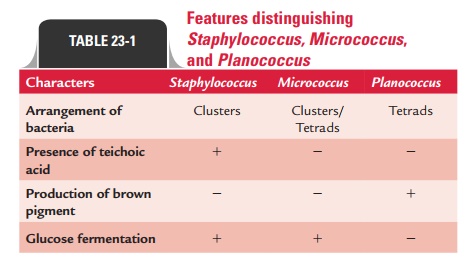Chapter: Microbiology and Immunology: Bacteriology: Staphylococcus
Staphylococcus
Staphylococcus
Introduction
Family Micrococcaceae consists of Gram-positive cocci, which are aerobic and anaerobic, and are arranged in tetrads or clusters. Micrococcaceae consists of four genera, Staphylococcus,Micrococcus, Planococcus, and Stomatococcus. Differences betweenthese genera are summarized in Table 23-1.


Human infections caused by these genera are summarized in Table 23-2. Among these, Staphylococcus is the only genus of medical importance.
Staphylococcus
The genus Staphylococcus consists of 32 species, most of which are animal pathogens or commensals. The bacteria belonging to this genus are aerobic and facultative anaerobic, catalase positive, oxidase negative, and are arranged in clusters, pairs, or tetrads.
· Staphylococcus aureus is the most important human pathogen.
· The other important human pathogens are coagulase-negative staphylococci (CONS), which include Staphylo-coccus epidermidis, Staphylococcus saprophyticus, Staphylococcus haemolyticus, Staphylococcus hominis, Staphylococcus warneri, Staphylococcus saccharolyticus, Staphylococcus schleiferi, and Staphylococcus lugdunensis. Staphylococci are capable ofacquiring resistance to many antibiotics and therefore can cause major clinical and epidemiological problems in hospitals.
Related Topics